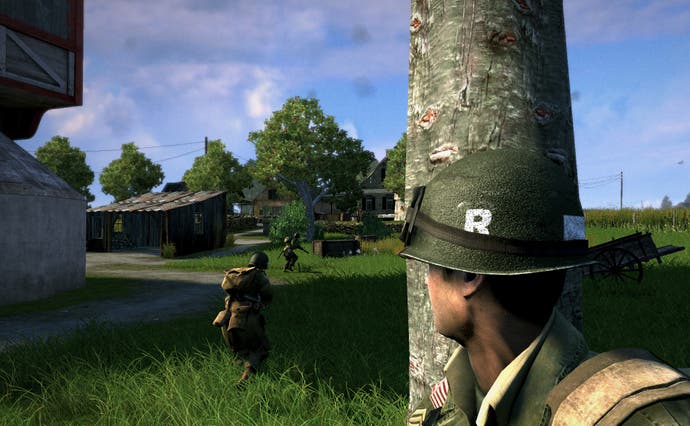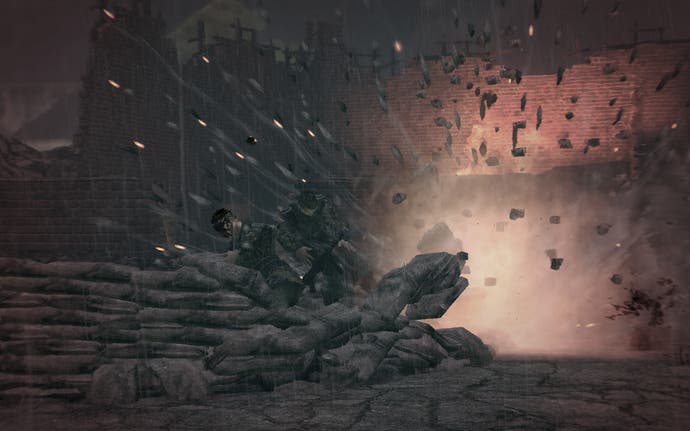Brothers in Arms: Hell's Highway
Middle of the road.
Unlike previous Brothers In Arms titles, your health is no longer something to explicitly worry about, with no health bar or meter to fret over. Instead, the game effectively assumes that getting shot is a Very Bad Thing, and bases your 'health' on the amount of time you spend exposed in a dangerous position. Stay exposed for too long, and the screen will go increasingly blood red until, kerpow, your enemy finally gets a bead on you and you hit the deck. Ducking back into cover returns the colour balance back to normal, so you have an instant, reliable indicator as to when it's safe to poke your head above cover and start firing back in earnest.
This cat-and-mouse game of cover and retreat, while a little on the forgiving side and completely unrealistic, definitely works on a pure gameplay level. You can predictably and reliably know that as long as the screen isn't too red, you're okay. It not only informs you of when you're capable of returning fire, but roughly for how long, and aids those perilous sprints between cover points. In a very obvious nod to Gears of War, you can run by holding down A (or X on PS3), but you can't fire. Fortunately, it's a damned sight easier to 'steer' your man while doing so than it was in Epic's game, which is a relief. In terms of how you use the cover points, simply pressing LB/L1 makes Baker sidle snugly up to any cover point, and peeking out from behind it is as simple as moving the left stick in the appropriate direction.
After a few missions, the game's invisible tutorial schools you seamlessly in all aspects of the game, and you cannot argue with the solid fundamentals. Everything which made the original compelling returns in a bigger, better, more technically accomplished fashion, and the battlefields offer a more expansive challenge on the whole. But does it go far enough?
In a word, no. The game's biggest problem is a crushing lack of variety. Set over ten chapters, by the time you're four or five in, the sense of grinding repetition has settled. With the enemy permanently set up in predictable formation, it really does become a case of picking off the cannon fodder, blasting through weak defenses, flanking and repeating until bored. Admittedly, some of the later chapters amp up the number of enemies you face at once, but the formula remains stubbornly repetitive. Why didn't Gearbox experiment with enemy behaviour, and get them to try and outflank you, or put you in situations where enemies are coming at you from unpredictable directions? Constantly facing enemies that only appear in front of you just feels incredibly old for a game which prides itself on strategy and authenticity.

But Hell's Highway's problems aren't strictly about boredom through incessant repetition; it's the general ease with which you can breeze through levels almost by yourself, even on the so-called Veteran level. Thanks to the deadly accuracy of the iron sights aiming system, you can pick off most enemies yourself from an almost impossible range with a basic rifle, which is ludicrous. Meanwhile, you could have three squadrons of four training their fire on a specific area and they'd struggle to pick off a single enemy if you left them firing for a week. It's all very well giving you control of a squad, but it'd be nice if they could take the initiative more than they do. Time and again, the game sits there waiting for you to pick off enemies yourself; in truth, your squaddies offer little more than a means of mopping up stragglers, and a suppression device. The only thing that slows you down in the game is the inconsistent checkpointing system, where sometimes you're forced to wade through large sections without saving. If you happen to get caught out, it's a real bind to get forced back 10 or 15 minutes.
Equally disappointing is how limited the level of destruction is, especially when it has such profound implications. While it's initially great to see enemies blown to smithereens in slow motion as you rip through their cover points, the extent of what you can destroy is limited next to, say, Battlefield: Bad Company. Buildings remain impervious to attack, wrecked vehicles remain anchored to the ground, and feeble corrugated shields remain in place no matter what. Having seen what's possible in other games that have been on sale for months, there are aspects of Brothers In Arms which simply feel dated. You feel there's a great gaming concept here, but that it hasn't really moved on enough from where it was nearly four years ago.
Indeed, although the game boasts Unreal Engine 3 tech, it's by no means the most impressive use of it, and the signs of a painfully protracted development process are never that far away. AI soldiers are regularly unable to effectively pathfind, or, worse, get caught in a running loop against a wall for 10 seconds before finally working out where to go. And, as we pointed out in the preview, why was it so hard to make the German soldiers you face have any facial variety whatsoever? The sight of four bodies all piled up with the exact same faces is the sort of comedy you don't expect at this stage. While it's fair to say the environments are reasonably pretty, there's never any real wow factor about any of it. In late 2008, it's functional stuff, nothing more.

As ever, Gearbox has made a lot of noise about the narrative drive of the game, but to these English eyes, the drama consistently feels overblown, and, towards the end, really quite cringeworthy. We're supposed to feel for these guys, and for how invested they are in the decisions they make that cause the deaths of their comrades, but it feels like the writers were trying too hard to pull our heart strings.
The promise of multiplayer often helps prop up a shooter's long-term appeal, but what's served up in Hell's Highway is lightweight to say the least. Essentially there's only one fairly basic team-based multiplayer mode (playable ranked or unranked, as usual), and six medium-sized maps. Matches support either 14 or 20 players, with the usual options to toggle round and prep times, friendly fire and whether voice-chat is enabled. Set-up is as simple as selecting from the available weapons (such as sniper rifle, machine-gun and bazooka) and diving straight into a simple attack or defend match. Attackers must raise the flag, while, obviously, defenders must ensure it remains lowered. From initial impressions, there's not a huge amount to it, other than trying take out your opponents and all converging on the flag. Apart from the ability to drive a tank, the action is familiar team-based run-and-gun stuff, albeit with more emphasis on making good use of cover. A little underwhelming if we're frank - no wonder Gearbox never once talked about or showed off this side of the game prior to launch.
At this point, Brothers In Arms: Hell's Highway represents little more than a solid evolution of the original, as opposed to being the game which takes strategic World War II action to dizzy new heights. With an engaging but ultimately repetitive play mechanic at its core, it deserves a decent amount of respect, but its charms wane rather than grow as it progresses. With little more than a rooftop sniper interlude and a trio of tank driving segments to break up the flow, Hell's Highway is short on surprises after the first few hours. It's by no means a failure, but simply lacks the inspiration to make it a must-have.

